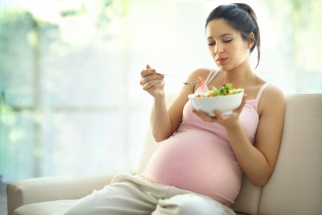June 2021
Healthy Eating While Pregnant or Breastfeeding
You’ve likely heard that a pregnant woman is “eating for two.” Well, it’s true—and the same goes for moms who are breastfeeding their babies. Now, there’s national nutrition advice specific to these moms-to-be and new mothers.

For the first time, the 2020–2025 Dietary Guidelines for Americans include recommendations for women who are pregnant or lactating. The guidelines reflect the fluctuating needs of a woman and her child during these significant life stages.
Extra calories and nutrients
While healthy eating looks similar before, during, and after pregnancy, women need more calories as their pregnancies advance and while breastfeeding. In general, the estimated daily calorie increases for women with healthy prepregnancy weights are:
-
First trimester: +0
-
Second trimester: +340
-
Third trimester: +452
-
Breastfeeding, first six months: +330
-
Breastfeeding, months seven to 12: +400
During this time, your body also requires extra nutrients to restore your own supply and support your baby’s development. Food sources are preferred, but your healthcare provider may advise you to take supplements containing folic acid, iron, iodine, or choline.
Talk with your provider about supplements, as well as your personal calorie and weight gain targets.
Foods to eat—and others to avoid
The best way to meet your nutritional needs is by eating foods that offer lots of vitamins and minerals, but little or no added sugars, saturated fat, and sodium. Bulk up on produce and whole grains. Protein should come from beans, nuts, lean meats, poultry, and certain seafoods. Opt for healthier oils—such as vegetable oils and those found in nuts—and fat-free or low-fat dairy products.
While there’s no need to avoid specific foods or beverages in hopes of avoiding future food allergies for your child, some substances can harm a developing fetus or breastfeeding baby. For example, alcohol and seafood that may be high in methylmercury.
Ask your provider what you should avoid or limit. Visit the Office on Women’s Health to learn more.
You have options
The Dietary Guidelines for Americans offer a flexible framework for healthy eating. You can adjust your choices to help manage your budget, preferences, traditions, and pregnancy-related symptoms, like nausea and vomiting.
But no matter what, always choose good nutrition. A balanced diet can help you and your little one enjoy better health now—and in the future.